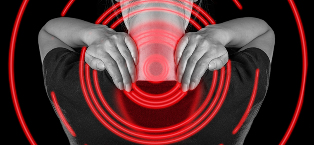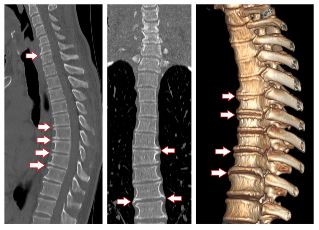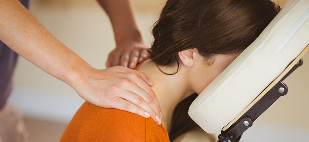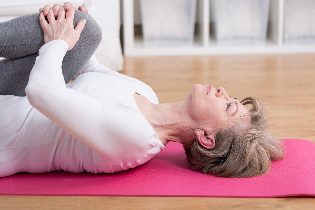Osteochondrosis is degenerate-degenerative of the defeat of tissues of the spinal column, which causes a shape change and erasure of the intervertebral discs, the vertebral bodies and joint surfaces. Usually, the degenerative processes in the first turn, affect the bones and ligaments. This disease is considered to be one of the most common causes of the onset of the pain in the back.
Most of the cases, the diagnosis of degenerative disease of the disk falls on the lumbar. These statistics are natural, because this division of the vertebral column, which carries the weight of the entire upper part of the body. Osteochondrosis is witnessing a displacement of the vertebrae, and, therefore, it can develop intervertebral hernia or compression of blood vessels and nerve endings. Osteochondrosis is a very painful disease, which gives the patient a lot of discomfort and harm in the treatment.

The types of degenerative disc disease and its stage of development
There are four types of degenerative disc disease. The disease is divided into groups on the place of location:
- osteochondrosis of the lumbar spine;
- osteochondrosis of the cervical spine;
- osteochondrosis of the thoracic spine;
- common osteochondrosis – the defeat of two or more departments of the vertebral column.
The explanation of the location of the degenerative disc disease is very simple – the disease develops in these departments, which are the most pressure and great mobility.
The disease develops in stages, from the premises of the common symptoms of the event. The stage of development of the degenerative disease of the disk are the following:
- The instability of the vertebrae, caused by the violation of the location disc. At this stage, the patient feels uncomfortable during the movements affecting the affected area of the disease of the division of the vertebral column. At this stage of the degenerative disc disease of the spine is very prone to injury.
- The destruction of the fibrotic ring of the discs, intervertebral the slot of reduced size.
- The stage is characterized by the rupture of the fibrotic ring and domed one or more institute of discs. Appears intervertebral hernia and not deform the line of the spine.
- Because of bony growths of movement of the patient is limited, a syndrome of intense pain. Costeniuc the ligaments of the spine.
One of these steps in the successful treatment of degenerative disc disease is still possible, but more far, the more difficult it becomes to get rid of its consequences, and in the last step of getting rid of a disease completely impossible.
The reasons for the development of degenerative disc disease
The complete list of the causes of disc degeneration is very large. It includes the individual factors and their combination, become the cause of displacement of intervertebral disc. But most often lower back pain develops because of these reasons:
- heredity – if one of the parents was low back pain, the man falls into the risk group, because the structure of the intervertebral cartilage is often hereditary;
- a lot of hard work, the workload that exceeds the health standards for workers;
- a long stay in a posture can also become an important factor. Often pain in the lower back are diagnosed in individuals in sedentary occupations;
- a variety of diseases of the back, leading to a deformation of the spine;
- beriberi and vitamin deficiencies;
- the back injuries;
- infectious diseases;
- congenital anomalies of the spine, which lead to the quick erasing of the intervertebral disc;
- the natural aging of the body;
- obesity;
- the constant stress;
- hypothermia.

The symptoms of the degenerative disease disk
According to the place of location of the disease, its symptoms can vary widely. This is due to the fact that the protrusion of the disk and the entrapment of the vessels working on the next organs and tissues, causing a number of symptoms inherent in just with the belt of the spine. Therefore, examine the symptoms of different types of the degenerative disease disk should separately.
The symptoms of the degenerative disease of disk lumbo-sacral spine
Sciatica (or simply lumbar) of the osteochondrosis is the most frequent type of this disease. The kidney acts as a shock absorber when the majority of movements and turns, performed by a person. The symptoms of the localization of the disease in this department are:
- the pain in the lower back, worse during exercise, tight turns, or find a long period of time in the same position. The pain is typically throbbing, severe pain, early occur very rarely and may serve as a symptom intervertbral hernia;
- the pain in the legs caused by pinched roots of the spinal cord. This kind of pain can be different – shooting, dull, spread on one side of the hip;
- a reduced mobility, the patient is experiencing pain in the bends, slopes and the seat. If the patient takes more comfortable for him, the posture, the pain goes away.
If You find similar symptoms, contact your doctor immediately. Easier to prevent disease than to treat the consequences.
The diagnosis
For the diagnosis of osteoarthritis of the back doctor-neurologist calls such studies of the spine, such as:
- x-ray;
- ct scan;
- the magnetic resonance imaging.
How to treat pain in the lower back
In most cases, the treatment of degenerative disc disease is made, conservative methods. A doctor who specializes in the treatment of degenerative disc disease and other diseases of the spine, called the vertebral column. They are always assigned to several types of treatment, including drug tools, PHYSIOTHERAPY and other methods. The most common ways of treatment of degenerative disc disease:
- physiotherapy;
- different types of massages
- medications;
- traction;
- reflexology;
- manual therapy;
- PHYSIOTHERAPY.
Let's examine each of these methods is the nearest.
Physiotherapy
Almost always applied in the treatment of the lumbar region of the degenerative disease of the disc. During the physical therapy are tried laser, ultrasound, and vibration, which help to reduce the pain. It also helps to neutralize the inflammation. This method allows to reduce the doses of medications required for pain suppression. The side effects are absent.

Therapeutic Massage
The therapeutic massage provides the same positive results, such as physiotherapy. But you can't apply at a time when the disease is in the acute phase. The massage course in the period of remission has a positive effect on the state of the nervous system, relieves pain and excess muscle tension, stimulates blood circulation and strengthens the walls of blood vessels. In addition, the therapeutic massage can improve the body's resistance to disease and to normalize metabolism.
But for a therapeutic massage, there are some contra-indications, that may make its use impossible. It is especially the disease of the skin, open wounds, inflammatory processes in the body.
Drugs
The drug treatment of the degenerative disc disease cervical, thoracic, and lumbar is almost always. Generally, the drugs are applied in the period of exacerbation of the disease, and their action aims to reduce the symptoms of pain. Tablets, ointments, gels, and capsules are divided into types depending on the spectrum and of its species. There are funds for the reconstruction of the cartilage, of the ointment to the stimulation of the blood circulation, gels with the warming effect of other means to establish the functions of the propulsion system of the organization.
Reflexology
Reflexology is usually used in a complex with a massage. It is based on the good influences in the pressure points, and common parts. As a method of such treatment does not apply, but it is a good complement to other methods of treatment of degenerative disc disease of the cervical spine and other types of this disease. Reflexology relieves pain, recovers natural load on the various points of the spine, but has a very short duration of the effect.
LFK
Physiotherapy is considered as the main method of treatment of degenerative disc disease, regardless of its location. It is a very effective method that is within the limits of the load on the joints and muscles strengthens the back muscles. The exercises osteochondrosis cervical performed only under the supervision of an instructor or according to its recommendations. Do the exercise, you can at any age and regardless of the form of the degenerative disease of the disk, with the exception of cases where the disease is in the acute phase, and significant back injuries, which can worsen. The exercise helps to get rid of back pain, it will reduce the flexibility of the spine and improve the well-being of the patient.
Gymnastics, medical, low back pain includes a set of exercises that do not require great physical effort, and focused on the slow introduction of the tonicity of the muscles of the patient. Run, they can both by the patient, with the participation of a physician and with the additional application of training equipment. PHYSIOTHERAPY are these types methods:
- the mechanotherapy – these exercises are done by the patient on the special devices and simulators. The method applies if a serious measure of lesions of osteochondrosis of the spine, when the movements of the man hindered. This method also allows you to the need to develop groups of muscles and contributes to the improvement of the posture;
- the physiotherapy services of the breathing and physical exercises, and the effects of which are transmitted directly to the area of development of degenerative disc disease. The course is individually developed for each patient and helps to improve the mobility of the joints, the muscle tone, elasticity of the ligaments and tendons;
- terrenkur hiking, which is a complex of simple exercises and exercise. With the help of this method, you can achieve to improve the functioning of the cardiovascular system, improve endurance and to establish a respiratory function;
- hydro physiotherapy – sport, year in which are performed in the pool. Usually takes place in the sea or hot water. The exercises help to strengthen muscles, joints, and ligaments, as well as to improve the well-being of the patient;
properties swimming is a good method of prevention and treatment of various types of the degenerative disease of the disc. Helps you adopt a correct posture and naturally the position of the joint of the spine. Swimming can even help in the correction of the deformation of the vertebral column.
The treatment of degenerative disease of the disc with the help of gymnastics
Osteochondrosis of any type of need in the treatment method of small loads and exercises. This approach allows not only the most quickly as possible to get rid of the pain and discomfort, but also accelerates the overall process of treatment, recovers posture and flexibility of the spine. Each type of degenerative disease of the disc assumes the treatment of different types of exercises. According to the place of localization of disease complexes can be targeted on specific groups of muscles and vertebrae.
Exercises lumbar osteochondrosis
The most effective method of treatment of degenerative disc disease of the lumbar spine is considered as the swimming. Also, it is recommended complex of exercises in the gymnasium and gymnastics, medical. Most of the exercises are designed to strengthen the muscles of the back. One of the most common of the year – "the bike". It runs lying on the back. The patient performs leg movements, imitating the rotation of the bike pedals. Another popular exercise – while resting on the elbows bent need to fold it several times in the chest area, and secure it to the installation of 4 seconds. Repeated year is not more than five times in a complex. With a rate of charges must be governed by the patient. If health allows, little by little, they can increase, and if the patient at the time of execution of gymnastics feels the pain, and then exercise, you need to interrupt or suspend temporarily.
The exercises osteochondrosis cervical

The treatment of cervical osteoarthritis request the appointment of a gym of two types:
- exercises for the cervical spine, in which the amplitude of the movements is minimal. The patient himself creates a resistance to the movement of the neck hand. The exercises aim to overcome this resistance, in consequence of which, and which strengthens the group of muscles of the neck;
- the second part of the methodology involves dynamic exercises and circular turns of the head, improve the joint mobility of the cervical spine. All of the exercises for strengthening the neck, must be performed at a slow pace, without sudden movements and without significant loads.
As a complement to the exercises can be terrenkur and healing of the swimming. The two methods of treatment are directed on the same as physiotherapy exercises to improve mobility of the cervical vertebrae.
Exercises for low back pain and thoracic
Characteristic of a treatment breast of the degenerative disc disease is that most exercises are performed standing up. The most popular option, has enabled the majority of patients with this diagnosis – mahi hands, and the inclinations of the trunk. Warm up before the gym is done in a sitting position on a chair. On inspiration, the patient put the hands on the nape of the neck and deforms to hurry to the upper part of the back of the chair. On the exhalation, the patient fails the arms along the body.
Another therapeutic exercise in osteochondrosis is progibanija standing on its four legs. Absolutely all types of exercises should be performed slowly and without sudden movements. Patients with osteochondrosis and chest are also useful in swimming, the mechanotherapy and hydro physiotherapy.
The danger
Osteochondrosis without treatment leads to complications such as:
- vascular dystonia;
- sciatica;
- intervertebral hernia;
- the violation of the oxygen supply to the brain.


















































